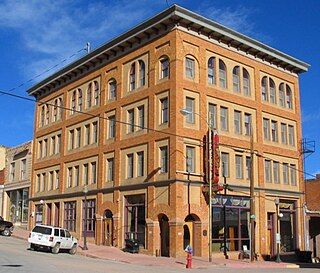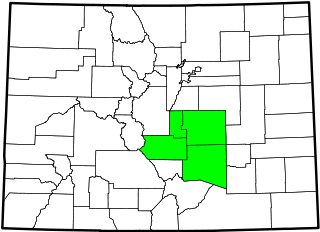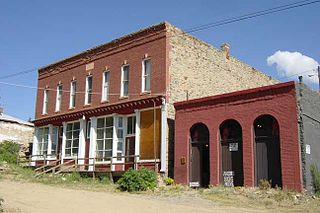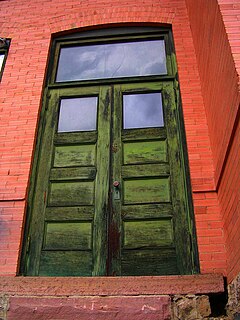
Custer County is a county located in the U.S. state of Colorado. As of the 2020 census, the population was 4,704. The county seat is Westcliffe.

Ward is a home rule municipality in Boulder County, Colorado, United States. The population was 150 at the 2010 census. The town is a former mining settlement founded in 1860 in the wake of the discovery of gold at nearby Gold Hill. Once one of the richest towns in the state during the Colorado Gold Rush, it is located on a mountainside at the top of Left Hand Canyon, near the Peak to Peak Highway northwest of Boulder at an elevation of 9,450 feet (2,880 m) above sea level.

The City of Victor is a Statutory City in Teller County, Colorado, United States. Gold was discovered in Victor in the late 19th century, an omen of the future of the town. With Cripple Creek, the mining district became the second largest gold mining district in the country and realized approximately $10 billion of mined gold in 2010 dollars. It reached its peak around the turn of the century when there were about 18,000 residents in the town. Depleted ore in mines, labor strife and the exodus of miners during World War I caused a steep decline in the city's economy, from which it has never recovered. The population was 397 at the 2010 census. There is a resumed mining effort on Battle Mountain.

The Wet Mountain Valley is a high elevation mountain valley mostly located in Custer County but extending southward into Huerfano County in south-central Colorado. Westcliffe and Silver Cliff are the two towns in the valley which is mostly devoted to cattle ranching.

The South Central Colorado Urban Area comprises the Colorado Springs Metropolitan Statistical Area, the Pueblo Metropolitan Statistical Area, and the Cañon City Micropolitan Statistical Area in the central and south central region of the State of Colorado. With the exception of northern Teller County and small portions of northern El Paso County, the entire South Central Colorado Urban Area is drained by the Arkansas River and its tributaries. The South Central Colorado Urban Area is the southernmost of the three primary subregions of the Front Range Urban Corridor.

Caribou is a former silver-mining town, now a ghost town near Nederland in Boulder County, Colorado, United States. It was named after the Caribou silver mine nearby. The Caribou Ranch recording studio is several miles away, on the road from Nederland up to Caribou.
Alpine, elevation 9,269 feet (2,825 m), is a small community, sometimes considered a ghost town, in Chaffee County, Colorado, United States. It was founded in the 1860s as a mining town.
Altman is a ghost town in Teller County, Colorado, United States. Much of the town was destroyed by fire on May 24, 1903.
Rosita was a silver mining town — now a ghost town — in Custer County, Colorado, United States. Rosita is Spanish for little rose. Although the old town has almost entirely disappeared, the surrounding area has been largely developed into semi-rural home sites.

Dyersville was a mining town — now a ghost town — in Summit County, Colorado, United States. It was named after Methodist minister John Lewis Dyer. Nothing remains of the town except the roofless walls of a couple of log cabins.

Nevadaville was a gold-mining town in Gilpin County, Colorado, United States. It was also known in the 1860s and 1870s as Nevada City. The post office at Nevadaville was called the Bald Mountain post office, to avoid confusion with other Nevadas and Nevadavilles. The community is now largely a ghost town, although not completely deserted. The Nevadaville Masonic Temple that started in 1861 still holds regular meetings.

The Cripple Creek & Victor Narrow Gauge Railroad is a 2 ft narrow-gauge heritage railroad that operates seasonal tourist trains between Cripple Creek and the city's outskirts to the south. The railroad uses a revitalized section of the original Midland Terminal Railway and the Florence and Cripple Creek Railroad. The railroad's one station and around half of its route is located within the Cripple Creek Historic District, a National Historic Landmark.

Russell Gulch, is a former mining town, now largely a ghost town, in Gilpin County, Colorado, United States. Although the population was once much larger than today, and most of the larger commercial buildings stand empty, the town is not completely deserted.
Tarryall is a ghost town in northwest Park County, Colorado, United States. It is on upper Tarryall Creek northwest of Como, Colorado. It was once the county seat of Park County, but is now completely deserted.

Tincup, or Tin Cup, originally named Virginia City, is an unincorporated community in Gunnison County, Colorado, United States. The community was once a prominent mining town, but is now a community of summer homes with a few year-round residents. Many historic buildings are still standing and kept up. The only business or service in Tincup is a small store, open only during the summer months.
Aubrey Landing, Aubrey City or Aubrey is a ghost town at the mouth of the Bill Williams River in southern Mohave County, Arizona, United States. The town was founded before 1865 and was abandoned sometime after 1886. Aubrey Landing was inundated when Lake Havasu was formed.

Saints John, originally called Coleyville and later Saint John, is a former silver-mining town in Summit County, Colorado. About a mile from the town of Montezuma, Saints John was the site of one of the first silver discoveries in Colorado. Although no longer a town, it still has several inhabitants.

Mayday is a ghost town in La Plata County, Colorado, United States. It was named for the Mayday Mine.

Brockite is a rare earth phosphate mineral with formula: (Ca,Th,Ce)PO4·H2O. It crystallizes in the hexagonal system in the chiral space group 180 or its enantiomorph 181. It is typically granular to massive with only rare occurrence of stubby crystals. It is radioactive due to the thorium content.

















